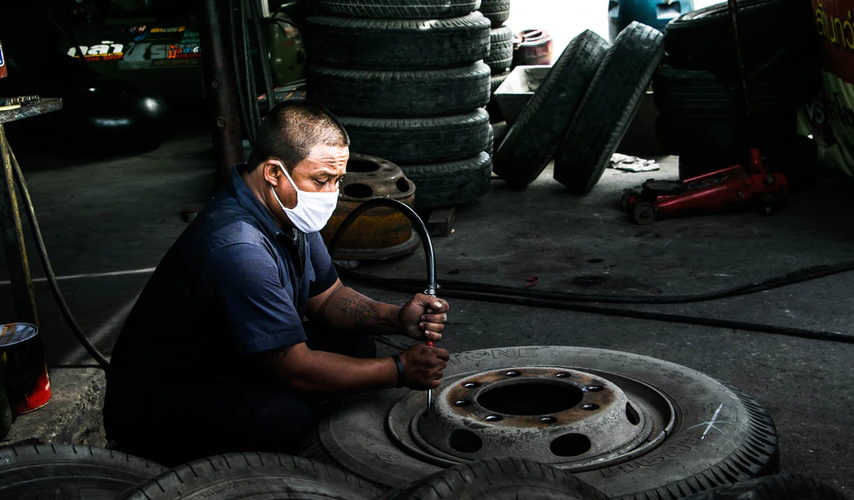The tires of your car are its most important safety feature. Tires provide traction that allows your car to stay mobile on the road while you drive. As it keeps you safe, it’s only right that tires are kept in good condition through maintenance.
Maintenance helps in keeping your tires as good in a condition they can be. So it’s important to look for wheel repair near your location in case of any emergency. With well-functioning tires, your car’s performance, and fuel efficiency is also sustained. You can also use well-maintained tires for as long as you would like, preferably until it reaches its six-year life expectancy.
There are several maintenance procedures that aid in keeping your tires in their best state. Here are 5 basic tire maintenance tips for all drivers out there to better understand good tire upkeep. You can also visit tyre shop open sunday.
- Tire rotation
It is essential to have your tires rotated consistently to gain maximum life and performance from them. This is one of the most important tire maintenance tips out there. Rotating your tires means repositioning them in specific patterns from front to back or side to side. All your tires operate at different loads and perform different steering and braking functions. This often results in uneven wear on their treads, which will lead to replacing them sooner than expected.
Tire rotation is usually performed once your tires have traveled at least 5,000 to 7,000 miles. By doing so, you basically even out the differences to reduce uneven wear on the treads by having them rotated. Uneven wear on your tire’s tread diminishes the traction that your tire’s need for better car handling.
If you’re using a performance car then your tires are designed to rotate in only a specific direction. Keep this in mind when having new tires installed at the best tire shops in the Philippines. See to it that your new car tires are rotated because fresh tire tread is more susceptible to uneven tire wear.
There are different types of patterns that you can follow when rotating your tires. The three basic patterns are rearward cross, x-pattern, and forward cross. The one that’s best for your vehicle depends on the type of tire that you’re using, whether your vehicle is front, rear, all, or four-wheel drive, whether your tires are directional or non-directional, whether both your front and rear tires are of the same size, and whether you have a full-size spare tire that can be rotated through.
- Tire Balancing
As you keep on driving your car over time, your tires lose their proper balance. This is due to the tire wear that causes the distribution of weight around your tires to change. You’ll notice this when you hear or feel an unusual shaking and vibration while you drive.
This tire maintenance tips periodically balances your tires, attaching a small weight to your wheel balancer that limit the vibration of the tire and wheels as they turn, which makes car rides more comfortable. It also reduces uneven wear on their treads. Newly installed tires should be balanced and thereafter if you notice a vibration. Balancing is also required after a tire is removed for repairs.
Balancing is done in a tire shop where they will put your wheel-tire unit on a machine that takes measurements to pinpoint lighter or heavier areas and makes adjustments to account for these weight differences.
- Wheel alignment
Wheel alignment, another important tire maintenance tips, is the measurement of the position of the wheels compared to the recommended specifications of the vehicle’s manufacturer. Sometimes referred to as breaking or tracking, it is a part of standard automobile maintenance. Each vehicle has its own specific settings of wheel alignment. If any alignment measurement goes past the specific range, it can result in uneven wear on treads, affect vehicle handling, and diminish fuel economy.
It’s advised that you check your tire alignment annually and when you have new tires installed. You’ll know if your wheels are in proper alignment when you drive your car down the road in a straight line without drifting or pulling to either side. The key to properly aligning your tires is having its angles adjusted which affects how they make contact with the road.
It is recommended that you have your wheels aligned after your tires have been balanced, as they both contribute the same thing to proper tire care: the prevention of uneven wear of your tire treads.
- Tire pressure
Over or under-inflated tires will not brake, steer, and accelerate properly. It results in irregular wear on treads and loss of control of your vehicle which causes horrible accidents. When under-inflated, your tires will have higher rolling resistance which causes a reduction in fuel economy. It also rapidly wears out the outer edges of the tread.
On the other hand, overinflation is less of an issue. However, if you over inflate them consistently, it will rapidly wear the center of the tread and will provide a less compliant ride.
The “right amount” of air for your tires is specified by the vehicle manufacturer and is shown on the vehicle door edge, doorpost, glove box door or fuel door, and your owner’s manual. Vehicle manufacturers provide basic tire pressure specifications that may vary from front to rear, and also when the vehicle is fully loaded or used for extended highway driving. Higher pressures increase load capacity and reduce heat buildup.
Keep in mind that you should not use the pressure that is molded into your tire’s sidewall. That indicates the pressure required to meet the tire’s full rated load-carrying capacity, not the pressure specified for your car.
- Inspect tire treads
Tires depend on good tread conditions to maintain traction and shed water on wet roads. You should check your treads at least once a month to make sure that you still have enough traction for safe driving. See to it that your tires are aligned and rotated regularly to preserve their treads.
Final thoughts
Hope these tire maintenance tips helped! Making sure that your tires are in great condition will prevent damages and accidents from happening. It starts with the day that you first bought your car and your replacement tires until it has reached its limit. Keep your tires in tiptop shape and you won’t have to worry much about your safety and your car’s drivability.
Author’s Bio:
Rosette has a knack for anything DIY, but not only that, she also knows a lot about manly chores and stuff as she spent her younger years immersed in books about hardware tools, equipment, and tires. As a child, she once dreamed of establishing her own hardware & tire store. Her career options may have changed, but today, she continues to write so passionately about her first love.













